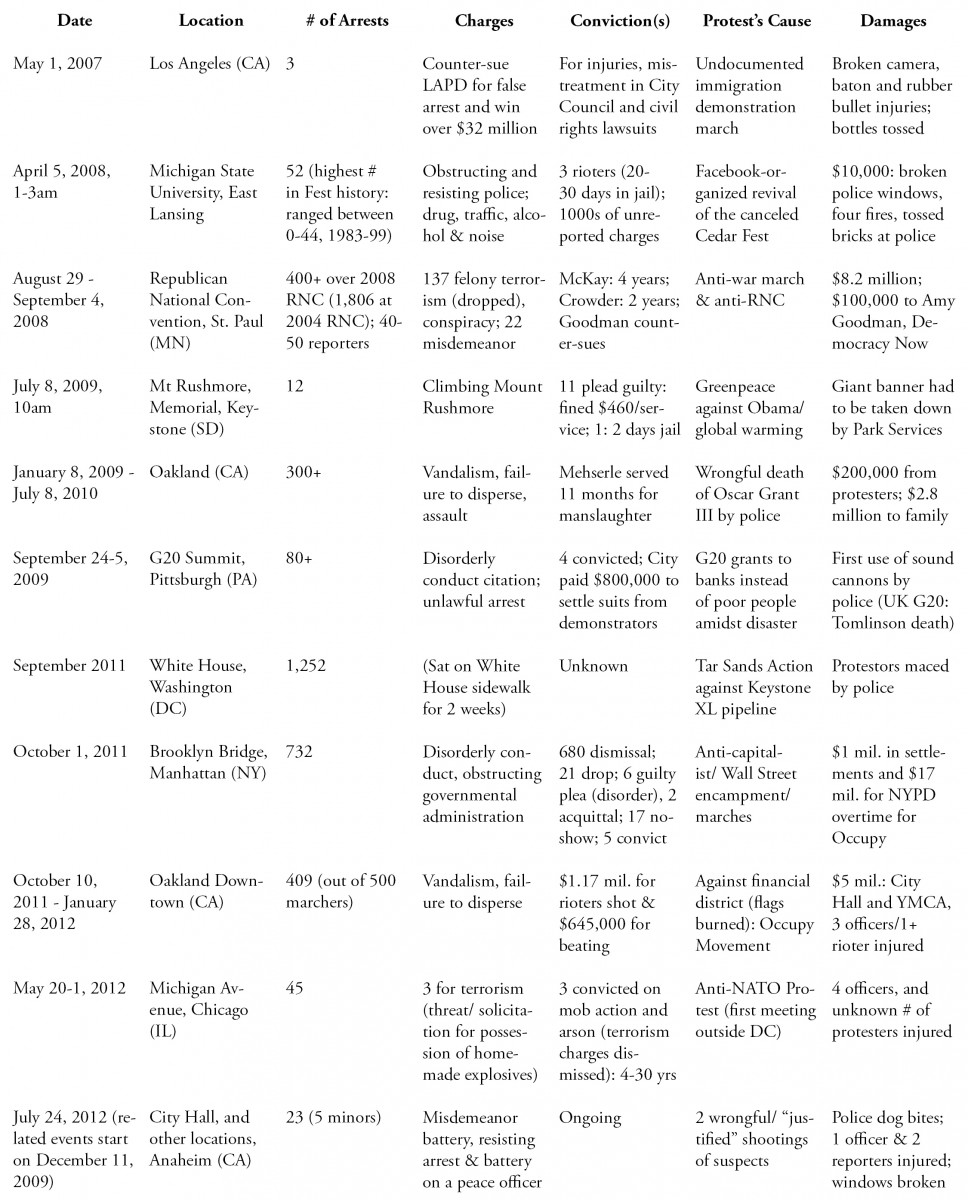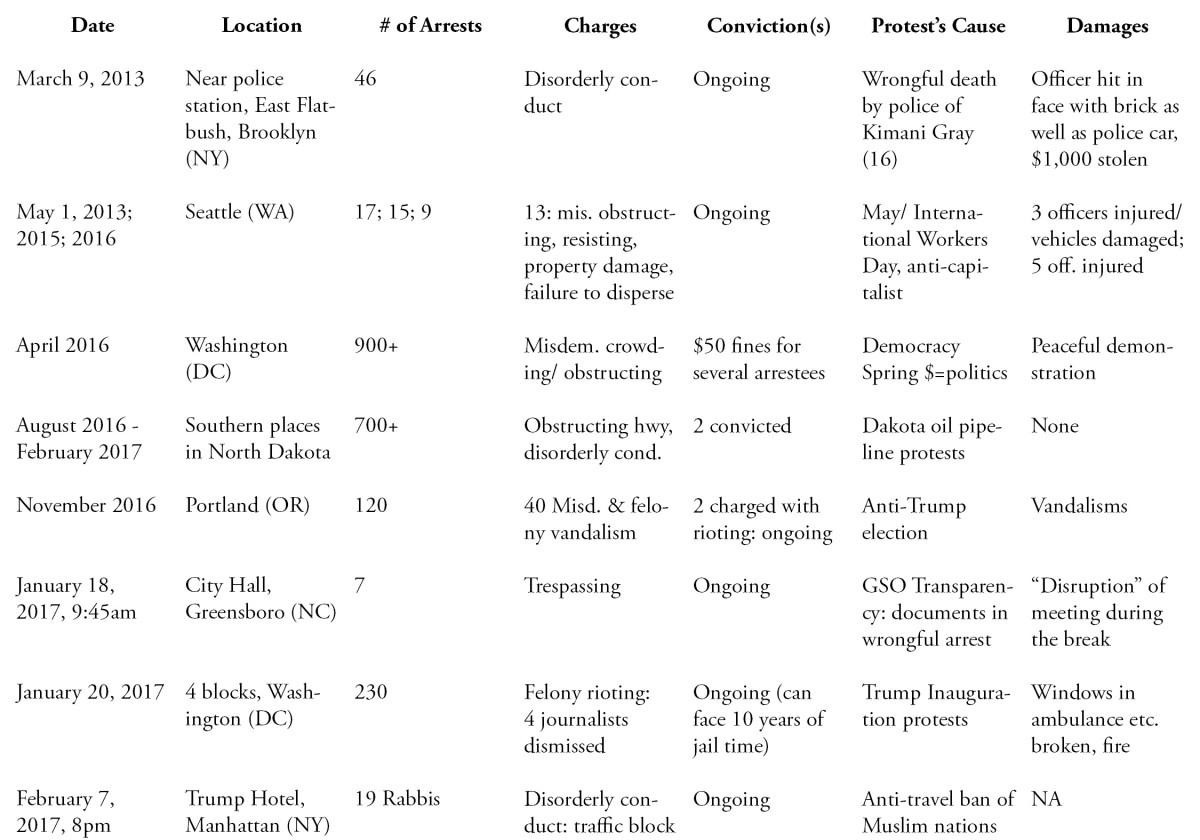
Civil disobedience has been practiced by peaceful protesters long before Henry Thoreau penned the essay with this name after a night in jail for refusing to pay the poll tax. In the US, when protester arrests are mentioned, Rosa Parks’ and Dr. Martin Luther King’s bus protest comes to mind together with an understanding of its roots in the Indian independence movement, led by Mahatma Gandhi. In the last decade, there has been a spike in publicized arrests that might only be rivaled by the combined civil movements of the 60s. Have these recent arrestable protests been successful? What were the reasons for the arrests? Are there patterns we can learn from?
One recent study, Why Civil Resistance Works by Erica Chenoweth and Maria Stephan, shows how it succeeded in the Iranian Revolution, 1977-9, the First Palestinian Intifada, 1987-92, and the Philippine People Power Movement, 1983-1986, but failed in the Burmese Uprising, 1988-90. In their review of previous literature on the subject, they argue that most scholars agree that violent revolutions, terrorism and other aggressive rebellions are more likely to succeed in contrast with the tamer method of non-violence (6). In contrast, they argue that civil resistance succeeds because of: “lower barriers to active participation in nonviolent resistance, the disruptive effects of mass nonviolent noncooperation, and the increased likelihood of backfiring and loyalty shifts during nonviolent campaigns.” (82).
The spike in recent arrests is demonstrated by the fact that prior to the death of Ian Tomlinson “(who was not a protester) at the G20 protests, in 2009, the last two people to die after contact with the police at protests in Britain were Kevin Gately, in 1974, and Blair Peach, in 1979,” according to David Mansley’s Collective Violence, Democracy and Protest Policing (75). He explains that statistics about protest-related arrests are difficult to find because individual police departments deny freedom of information requests, and there is no national database. Mansley also points out that new laws in the UK (and the US) make it easier to convict those charged with rioting; for example, he sites that “in Bristol in 1980, none of the sixteen people charged with riot were convicted. By contrast, the 183 people charged with riot under the new definition,” of the Public Order Act 1986 “in Bradford and other towns in 2001, 90 per cent were found guilty” (72).
There are some calculatable measures of the level of unrest, such as the Insurance Information Institute’s “Top 10 Most Costly U.S. Civil Disorders” list that reports the Los Angeles riots of 1992 as costing the insurance industry $1.3 billion in today’s money, with only 60s protests in Detroit and Los Angeles rivaling these numbers. The only event on the list from the last decade is from Baltimore’s April 25-7, 2015 incident that cost $24.3 million. Thus, civil unrest does not cost American businesses nearly as much today as it did in the 60s and 70s, so it is counter-intuitive that arrest statistics for protests seem to be going up.
A PLOS study showed extremely sharp decreases in the number of civil unrest incidents across the world in Asia, Africa, Europe and America from 1919 to 2008, focusing on demonstrations of over 100 individuals in “general strikes, riots, and anti-government demonstrations” that were reported in the New York Times, 9,455 “social unrest events” in total. Would these diagrams show a spike up at the tail end, if the decade after 2008 is considered?
Armstrong Economics seems to have one of the more detailed lists of major “US Civil Unrest Incidents.” It includes 25 incidents between 2007 and 2013. So, I will use it and the biggest news stories from 2014-2017 to compile a summarizing table on these incidents:


I took out several sports game and festival-related riots from the list because random destruction of property might show discontent, but little meaning can be derived from it. I included the resurrection of Cedar Fest in the list before deciding on this rule, and did not take it out because its organization was more of a political action organized via Facebook than mere rowdiness. This Fest has also seen regular arrests of participants before it was banned, so there’s something of a mystery to it that bares contemplation. There were also plenty of incidents where a single individual protested and was jailed for it, as in the case of Tim DeChristopher who bid $1.8 million he did not have on land that would’ve otherwise gone to oil and gas corporations and served 21 months for it. So, the above are arrests of more than one person after a pretty large protest, which has been covered in the news. There might have been thousands of protests that led to arrests that were not covered in the news, but I would not have been able to easily gather the needed data on them.
I noticed that in many of the mass arrests where 1,000 or more individuals were arrested, the organizers set out to break records of the number to be arrested, as was the case with the Tar Sands Action; they told protesters to bring $50 to pay the anticipated fine. On the other hand, some of the other mass arrests with only a few hundred people, as in the Brooklyn Bridge arrest that same year, the protesters were lured onto the bridge by the police, perhaps to meet some arrest quota the police had. The notion that any city can profit from civil disobedience arrests seems far-fetched as the costs of a mass-arrest are staggering. Oakland nearly bankrupted its police department when it was hit with a series of arrestable protests and had to fire a large portion of the department to cover losses from lawsuits, damages, and having to hire outside lawyers to prosecute all those they managed to arrest. Most mass arrests either end up with most of the protesters convicted on felony or misdemeanor charges. I wonder if millions in civil and federal settlements for the victims of wrongful arrests will end up incarcerated.
A few or even dozens or reporters are typically arrested together with the center of the crowd in most incidents, and they are usually briskly let out and if they were roughly handled in the exchange, they typically win lawsuits, as Democracy Now’s Amy Goodman did ($100,000).
The protesters typically win lawsuits if they did not veer off the course directed in properly obtained demonstration permits.
On the other hand, if they veer into a bridge that might cause traffic delays (Brooklyn), at least a few out of the hundreds can be proven with camera footage as being in the wrong. More importantly, if protesters spit, shove and otherwise harass powerfulRepublican politicians as they’re trying to celebrate their wealth at RNC, odds are some will be convicted. Many protests also fumble when participants indulge in drugs and alcohol as the Occupy Wall Street campout was doomed for this reason rather than any logistical difficulty with living outdoors. It is also pretty typical for the FBI and other agencies to suggest terrorist plots to wannabe protesters. The FBI agent meets a gullible (perhaps intoxicated) kid and proposes making some bombs to show the capitalists some heat. The kid then proceeds to agree to said plot, and might attempt to shop for the components, and this is when he (I haven’t seen any girls fall for this) is arrested and charged with terrorism. So, the lesson: if you meet a middle-aged guy who’s stoked about blowing something up, tell him to go and do it himself.
Perhaps the saddest conviction, for me, is that of the Greenpeace demonstrators that put a giant Obama banner on Mt. Rushmore: who was harmed by the banner? If they had spray-painted the monument, I’d agree that’s destruction of art, but the banner was taken down by Park Services within an hour.
Attempts to suppress a large crowd with mace, batons, and occasionally never-before-seen deafening noise machines frequently leads to injuries or even deaths of the protesters, but the protesters frequently start shoving or tossing items back at the police. If any police officer ends up with broken skin, these damages count as assault and the numbers of such injuries is always reported precisely in the news. The numbers of damaged protesters are always a matter of speculation, though speculation would suggest that nearly all those arrested by police are in some way assaulted as handcuffs are reported to cause pain and bruising on the wrists long after the encounter, and the police nearly always shove protesters down to the pavement first rather than politely asking them to turn around to get cuffed.
How do Obama, Bush and Trump compare in terms of the number and type of protestors? The two largest protester arrests took place in or at the end of the first terms of the Obama (1,252 over pipeline) and Bush (1,806 at RNC) presidencies. After this protest, Obama rejected proposals both for the Dakota and Keystone pipelines, which are now being revived by Trump. Bush did not adjust his policies despite the anti-Republican, anti-war, and pro-environment protests that he faced. Then again, the bulk of the other major protests in the Obama era were against Wall Street and rampant, unbridled capitalism put on welfare with infusions of government grants and loans as it was imploding under the weight of its own corruption. Trump is currently repealing the legislation against financial crimes and the like that Obama did manage to squeeze into place, but the changes were not significant enough for an apparent difference in the American corporate culture before and after Obama. There weren’t any major immigration protests for Obama (even though immigration policies were pretty similar to Bush’s), while Trump and Bush seem to be intent on agitating migrants, so this population is desperate enough to be arrested for their rights in Republican administrations. There was also a spike in peaceful and riotous protests over police brutality and slaughter of unarmed or unthreatening young men of color during Obama’s term, perhaps because this segment of the population voted for Obama with the expectation that he would be able to skew the system so that they would be less disenfranchised.
Could a president more intent on fixing the problem of unjustified deaths of suspects have managed to create policies to bring this about? If he had, perhaps there would not be the thousands of arrests at demonstrations shown in my summary diagram. Police are the ones arresting demonstrators, and it’s their brutality or sense of righteousness that can change these statistics.
The problem might also be that some groups (that represent the opposite extreme) deliberately place a few violent or vandalizing protesters in the mix of otherwise civilized marchers to bring about an altercation that would be cause for mass arrests.
Democracy Now reports that “according to one count, as many as 4.6 million people took part in the global day of action.” And since Democracy Now’s reporters have been in the middle of many of these protests, I think their estimate is to be believed. Out of these 4.6 million protesters, around a couple million were in the US, and of these only 230 were arrested in a single 4-block area of DC. In comparison, there were 500 marchers in Oakland in 2011 and 409 of them were arrested. Thus, the Inauguration protesters are to be applauded for their very civil, polite and nearly un-corruptible protest. Fox News has been reporting that “liberals” suffered a “complete meltdown” since the Trump election, but this is far from the truth as if 4.6 million people suffered a “complete meltdown” while protesting… there would not be much of DC left standing.
I hope these conclusions and statistics will help those of you who plan on protesting to do so responsibly and effectively.
Sources of Information
“Listing of US Civil Unrest Incidents”: Armstrong Economics
“Global Civil Unrest: Contagion, Self-Organization, and Prediction”: PLOS
Insurance Information Institute’s “Top 10 Most Costly U.S. Civil Disorders”
Collective Violence, Democracy and Protest Policing
Suppressing Protest: Human Rights Violations in the U.S. Response to Occupy Wall Street









